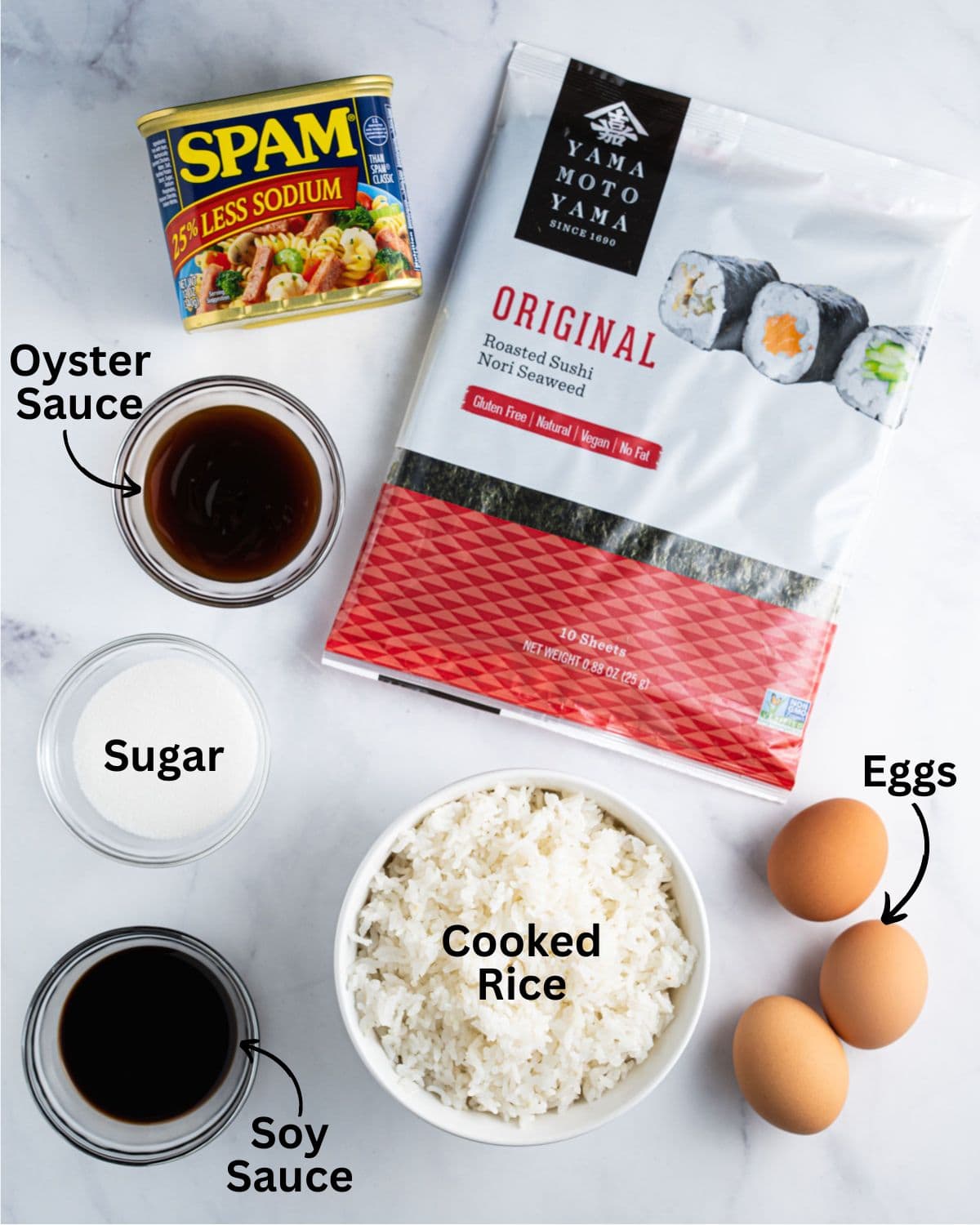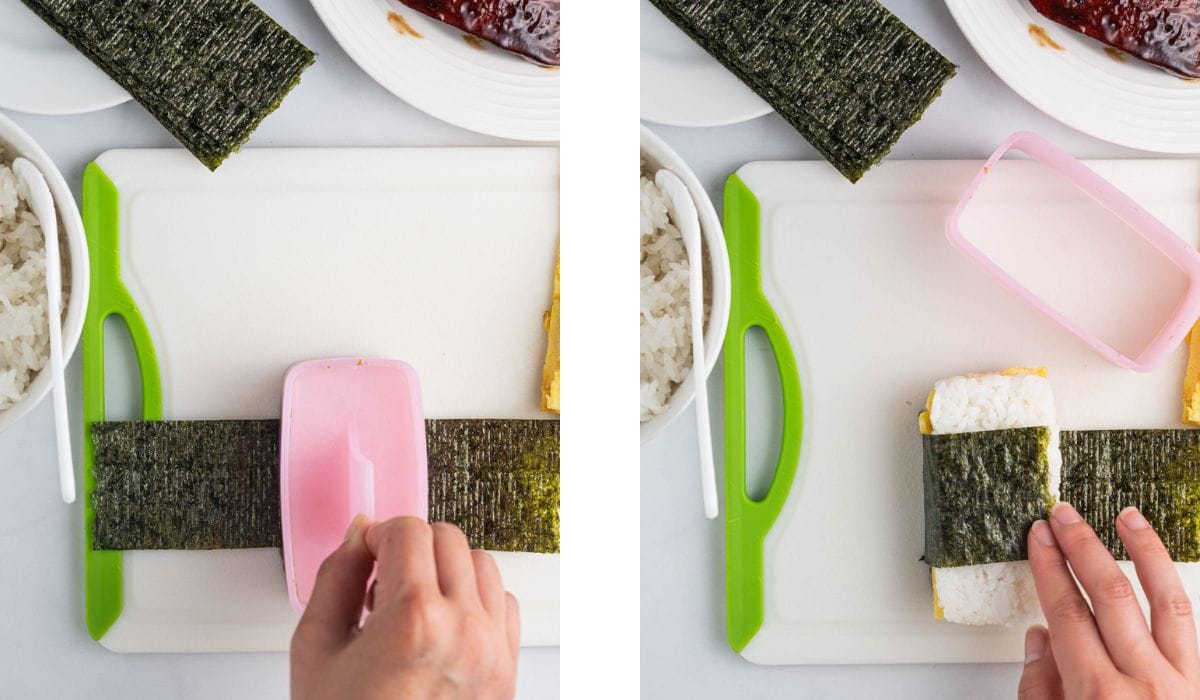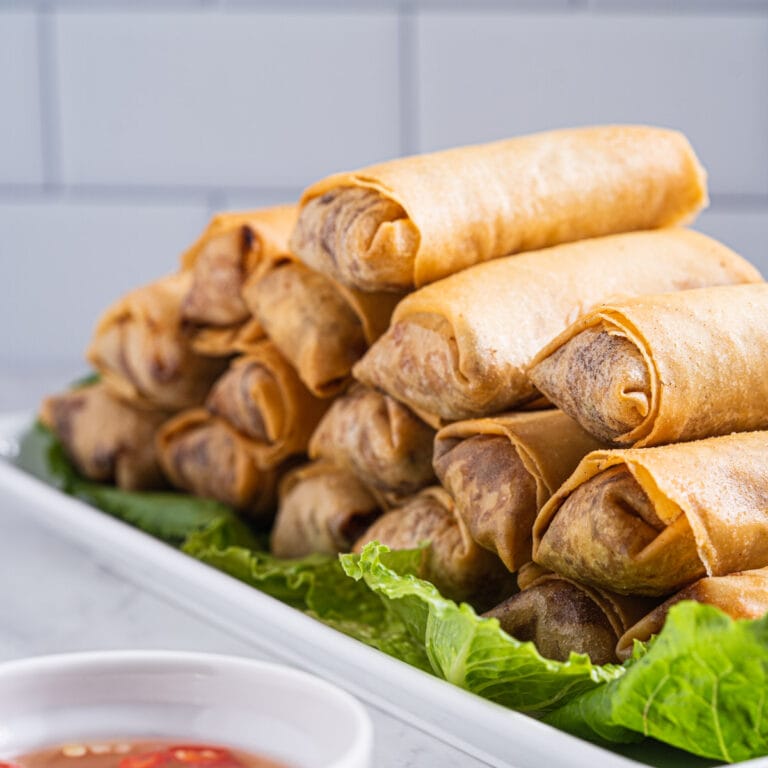Spam Musubi with Egg
Spam musubi with egg is a popular snack in Hawaii and a twist on the classic musubi. Brace yourself for a mouthwatering symphony of flavors as the savory goodness of Spam meets the velvety embrace of a perfectly cooked egg, all wrapped up in a delicious sushi-style package. Not only does it taste great, but it also makes for an easy snack or meal on the go. It’s a great way to experience local Hawaiian cuisine at home.

What is Spam Musubi?
Spam Musubi is a popular snack originating from Hawaii. It consists of a slice of Spam, which is a processed meat product made by Hormel Foods Corporation, placed atop a block of rice and wrapped in seaweed. This delicious snack has become so popular in the Hawaiian culture that it’s even served alongside traditional Hawaiian dishes at luaus and other parties. The snack has even become a staple in local convenience stores, making it easy to find while traveling throughout the Hawaiian Islands.

It can be served in many different ways; some people prefer to eat it on its own, while others enjoy it with a side of teriyaki sauce or even a bit of mayonnaise and soy sauce. There are also various types of spam musubi:
- Teriyaki Twist: Brush the Spam with teriyaki sauce before searing to add a sweet and savory flavor.
- Spicy Kick: Add a layer of spicy mayo or sriracha to give your musubi a spicy kick.
- Vegetarian Option: Swap the Spam for grilled or marinated tofu for a vegetarian version.
- California Roll Fusion: Incorporate avocado slices and cucumber to create a California roll-inspired Spam Musubi.
- Kimchi Explosion: Add a layer of kimchi for a tangy and spicy twist to your musubi.
- Pineapple Paradise: Place a pineapple slice on top of the Spam for a tropical and sweet dimension.
- Loco Moco Musubi: Top your Spam Musubi with a mini hamburger patty, a fried egg, and brown gravy for a loco moco-inspired treat.
Seriously, the possibilities are endless here!
What is Spam?
Spam meat, commonly known as Spam, is a brand of canned precooked meat product made by Hormel Foods Corporation. It is typically composed of chopped pork shoulder, ham, salt, water, sugar, and various seasonings and has become popular worldwide for its convenience and versatility in a variety of recipes, such as spam fried rice.
Why You’ll Love This Recipe
- The Ultimate On-The-Go Snack
- Easy to make
- Great for kid’s lunch (adults can enjoy them too!)
Ingredients Needed

Please scroll ⬇️ to the recipe card to see the full ingredient amounts and instructions.
- Cooked Rice: Cook the rice before starting. I used sushi rice but you can also use any short grain rice. Long grain will not work since it is not sticky enough.
- Spam: This recipe uses 1 can of spam, yielding around 6-8 musubis.
- Eggs: use 3-4 large eggs.
- Nori Seaweed Sheets: any sushi sheet can be used. This can be found at your local grocery store in the international section, at an Asian grocery store, or online.
- Oyster Sauce: used to flavor the spam. You can also find this at your local grocery store, Asian grocery store, or online. Feel free to skip this ingredient or use an oyster sauce substitute such as mushroom oyster sauce.
- Soy Sauce: used to flavor the spam. You can also use other soy substitutes, such as Liquid Aminos or Coconut Aminos.
- Sugar: the sugar balances out the saltiness from the sauces and spam.
Spam Musubi Mold
If you want to make Spam Musubi in the most authentic way possible, it’s best to use a wooden or plastic mold. With wooden molds, you can easily create perfectly shaped blocks every time. Plastic molds are also a good option and you can choose from many fun designs. Just remember to lightly grease the mold before assembling your musubis to prevent them from sticking.
Make Your Own Spam Musubi Mold
If you don’t have a spam musubi mold, you can also convert an empty spam can into a mold. There are 2 ways to make a DIY spam musubi mold:

- The first and easiest way is to use plastic wrap (larger than the spam can) to line the inside of the spam can. Then, layer in the ingredients as directed and firmly press down with a spoon. Lift the plastic wrap and ingredients out. It should resemble the shape of a musubi. Place musubi in the middle of the nori and wrap the nori around it. This is the easiest way without dealing with sharp edges or cutting the can.
- The second way is to use a utility knife or box cutter to cut the spam can two-thirds way down. Then, use duct tape to tape around the sharp edges. Follow the steps below to assemble your spam musubi.
How to make Spam Musubi with Egg
Step 1: Prepare the Spam and Nori. Cut the nori sheets into thirds or fourths. Slice the spam into 6-8 slices (depending on your desired thickness). Whisk together oyster sauce, soy sauce, and sugar in a small bowl until the sugar is dissolved. Add Spam to the soy sauce mixture and let it marinate for 10 minutes.


Step 2: Fry the eggs. In a small bowl, crack and whisk the eggs. Heat oil in a 12-inch skillet over medium-low heat. When hot, add the egg mixture, cover, and let it sit for 5-6 minutes or until cooked. Remove the egg onto a plate or cutting board. Place the musubi mold on top of the egg and use a knife to trace it around the inside.

Step 3: Fry the Spam. Remove the spam from the sauce and fry it on each side over medium heat until slightly crispy or until the desired doneness. Lower the heat and add the sauce; cook for 1-2 minutes until thickened.

Step 4: Assemble the spam musubi with eggs. Place the nori on a cutting board (shiny side down). Place the musubi mold across the middle of the nori. Add spam to the mold and press down firmly.

Step 5: Layer in the ingredients. Next, add the egg. Then, add the sushi rice, pressing down firmly and evenly so there is about 1-1 ½ inches of rice. Dip your fingers or the spatula in water as you go to prevent sticking. Use the top of the mold to press down. Wrap up one side of the nori and stick it to the rice, then wrap the other side. Repeat assembling the musubi until all the ingredients are used up.


Serve warm. Dip it with the sweet soy sauce, if desired.

⭐️ Tips for the Best Spam Musubi ⭐️
- Let the cooked rice cool before assembling.
- Gather and prep all the ingredients before starting.
- While layering in the sushi rice, wet your fingers or spatula with water to prevent it from sticking.
- Press the mold down with all your might! You want this packed tight to make it portable.
FAQ
Spam Musubi is a popular Hawaiian dish inspired by Japanese onigiri, featuring grilled Spam atop a block of rice, wrapped in nori seaweed, showcasing the unique fusion of Hawaiian and Japanese culinary influences.
Spam musubi sauce is a flavorful condiment made from a combination of soy sauce, oyster sauce, and sugar. It’s a sweet and savory blend that adds an irresistible depth of flavor to this popular Hawaiian snack. The flavors in the sauce perfectly complement the salty taste of the Spam used in Musubi.
Spam Musubi typically features cooked Spam, which is grilled or pan-fried, ensuring that the meat is fully cooked before being assembled with rice and nori.
The best rice for Spam Musubi is short-grain or medium-grain white rice, as it has a sticky and slightly chewy texture that helps the musubi hold together well. Short-grain rice, often labeled as sushi rice, is a popular choice due to its ability to adhere to itself, making it easier to shape and handle when assembling the musubi.
For the most traditional and authentic experience, a wooden or plastic Spam Musubi mold is the way to go. Wooden molds are easy to use and will give you perfectly shaped blocks every time. Plastic molds are also great and come in a variety of fun designs! Whichever type of mold you use, just be sure to lightly grease it before assembling your musubis so they don’t stick.
How to store and reheat leftovers
If you have leftovers, it is best to wrap each musubi individually with plastic wrap. It should last in the refrigerator for up to one week.
When you’re ready to reheat, microwave the musubi for about 10-20 seconds or until warm. If you prefer, place it in an oven preheated to 350°F and bake it for 3-5 minutes. Be sure to watch closely so that it does not become overcooked. Once heated, enjoy your delicious spam musubi with egg!
RECIPE

Spam Musubi with Egg
Equipment
- Spam Musubi Mold
Ingredients
- 1 (12 oz) can of Spam
- 3 large eggs
- ⅙ cup oyster sauce
- ⅙ cup soy sauce
- ⅙ cup sugar
- Nori roasted seaweed sheets, cut into thirds
- 6 cups cooked sushi rice
Instructions
- Prepare the Spam and Nori. Cut the nori sheets into thirds or fourths. Slice the spam into 6-8 slices (depending on how thick you like it). In a small bowl, whisk together oyster sauce, soy sauce, and sugar until the sugar is dissolved. Add Spam to the soy sauce mixture and let it marinate for 10 minutes.
- Fry the eggs. In a small bowl, crack and whisk the eggs. Heat oil in a 12-inch skillet over medium-low heat. When hot, add the egg mixture, cover, and let it sit for 5-6 minutes or until cooked. Remove the egg onto a plate or cutting board. Place the musubi mold on top of the egg and use a knife to trace around the inside.
- Fry the Spam. Remove the spam from the sauce and fry it on each side over medium heat until slightly crispy or until the desired doneness. Lower the heat and add the sauce, cook for 1-2 minutes until thickened.
- Assemble the Spam musubi with eggs. Place the nori on a cutting board (shiny side down). Place the musubi mold across the middle of the nori. Add Spam to the mold and press down firmly.
- Layer in the ingredients. Next, add the egg. Then, add the sushi rice, pressing down firmly and evenly so there is about 1-1 ½ inches of rice. Dip your fingers or the spatula in water as you go to prevent sticking. Use the top of the mold to press down. Wrap up one side of the nori and stick it to the rice, then wrap the other side. Repeat assembling the musubi until all the ingredients are used up.
- Serve warm. Dip it with soy sauce or oyster sauce, if desired.
Notes
-
- Let the cooked rice cool before assembling.
- Gather and prep all the ingredients before starting.
-
- While layering in the sushi rice, wet your fingers or spatula with water to prevent it from sticking.
-
- Press the mold down with all your might! You want this packed tight to make it portable.
-
- How to store leftovers: wrap each musubi individually with plastic wrap. It should last in the refrigerator for up to one week.








Thank you for sharing this traditional dish! I love being able to experiment with new flavors without traveling. Such a beautiful savory dish
I was so surprised how great this was. The mix of flavours were brilliant.
So excited for this recipe! Making it for family! Excellent step by step!
What a unique recipe! Looks like it is packed with protein. Thanks for sharing.
I’m intrigued by the flavors and textures in this spam musubi with egg. It sounds marvelous.